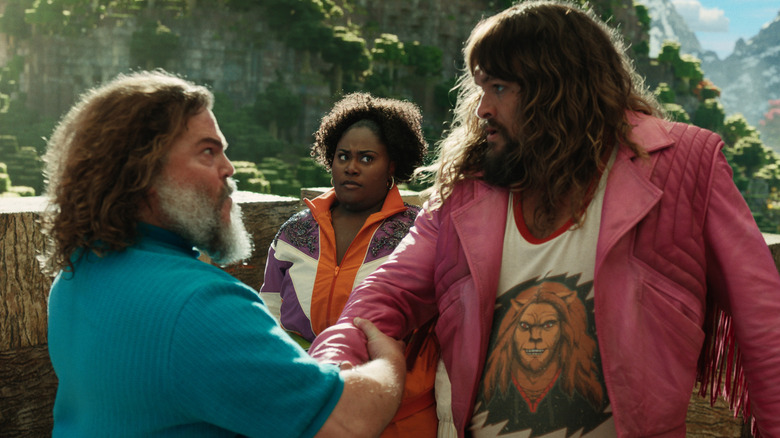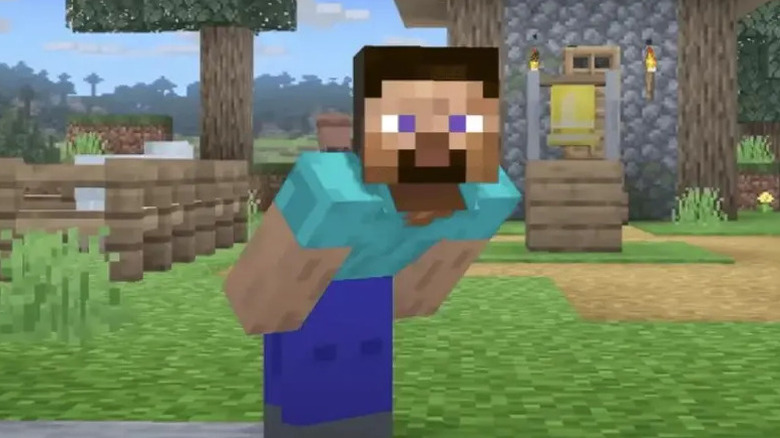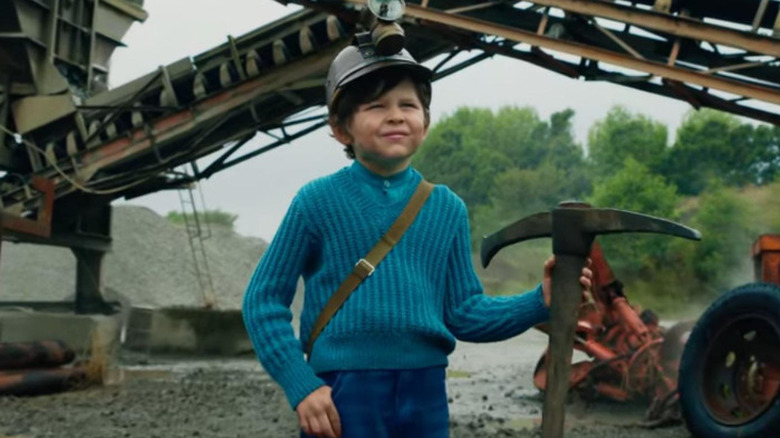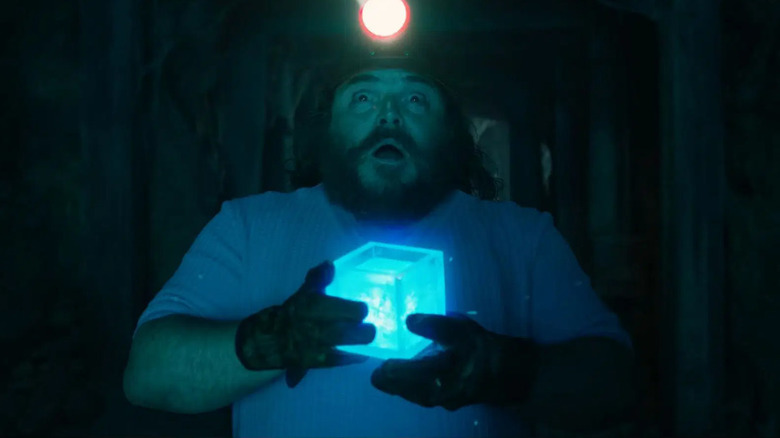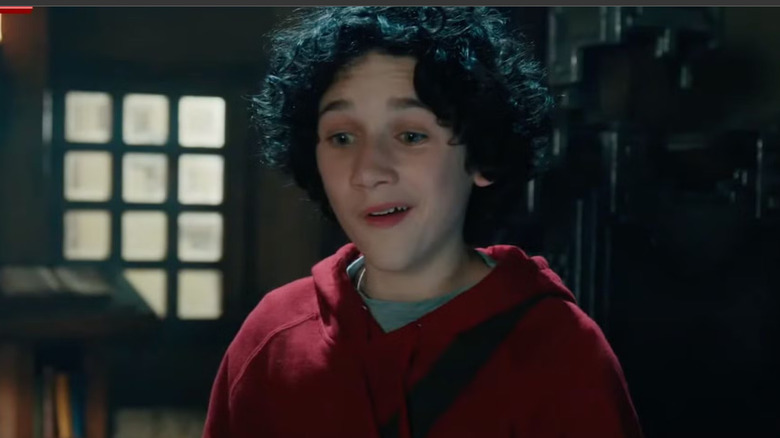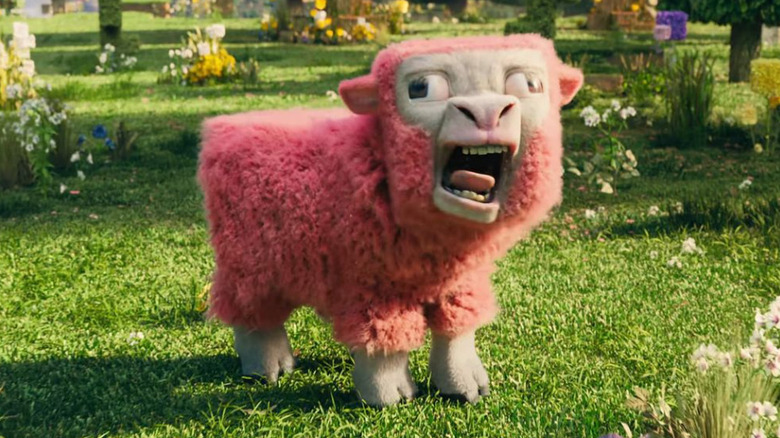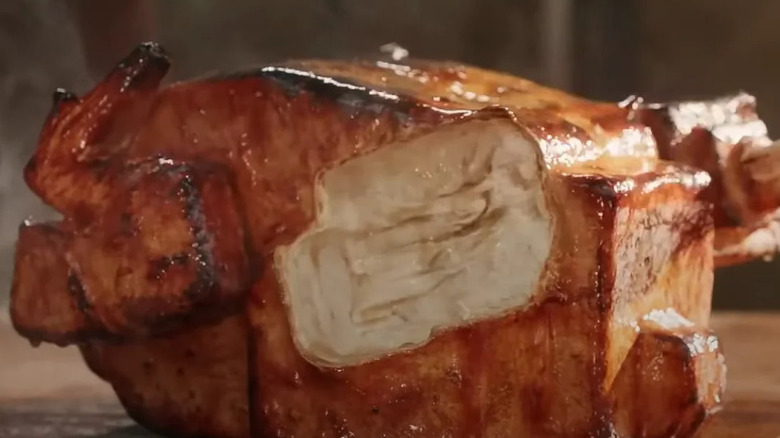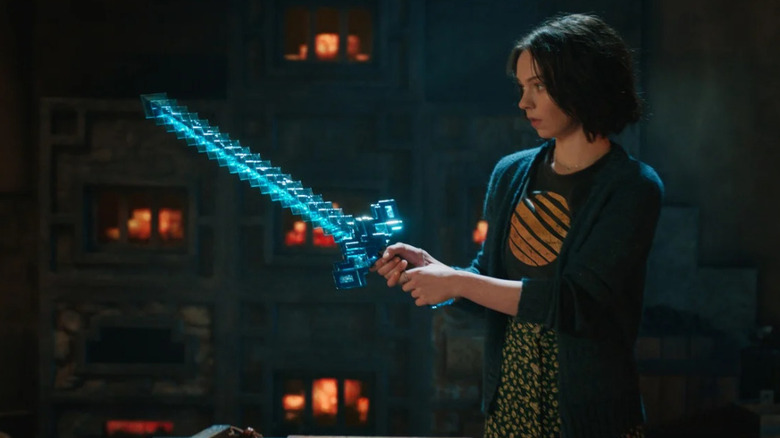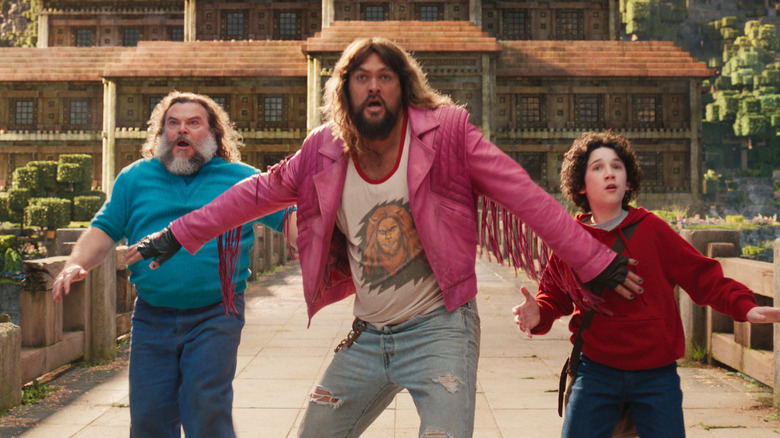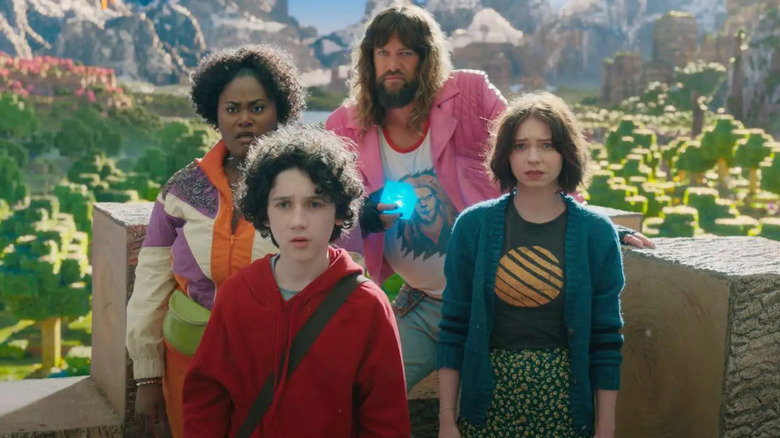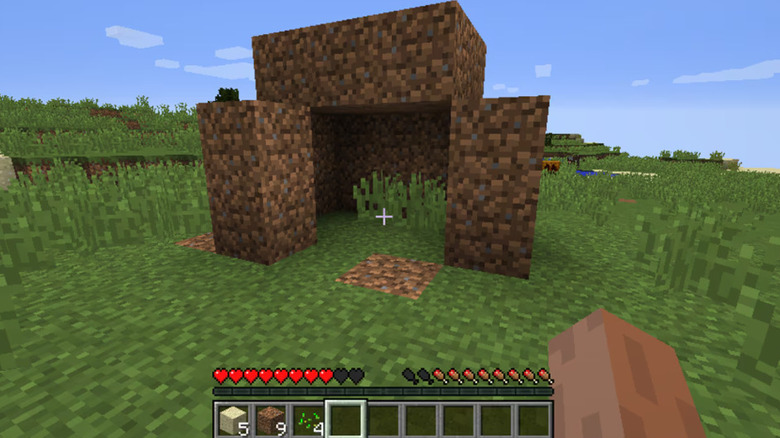Dumb Things We All Ignored In A Minecraft Movie
Contains spoilers for "A Minecraft Movie"
"Minecraft" is a massively popular video game, initially created in 2011 by problematic creator Markus "Notch" Persson before being sold to Microsoft. The game itself is a first-person crafting game, where you play as a blocky man (colloquially known as Steve, based on an off-hand joke by Persson), exploring an equally blocky, procedurally-generated world to mine elements and craft them into things like houses and weapons. There are also blocky animals to farm, shear, and eat, as well as blocky humanoid villagers to interact with. The game also boasts a day/night cycle where at night the player has to fight blocky monsters and creatures, including pig monsters, exploding Creepers, zombies, and Slenderman-inspired "Endermen."
Due to the game's immense popularity, it's no surprise that Hollywood would see dollar signs and attempt to adapt it into a film — despite the game's general lack of narrative. The movie itself, directed by Jared Hess, follows four humans from our world who get stuck in the Minecraft "Overworld," and need to team up with Steve (Jack Black) — who has been stuck there for years now — to get back home.
However, since the game has no narrative, the movie makes a lot of dumb choices in the process, and only confirms why we were worried about the "Minecraft" movie. Although it does not look like it will be one of 2025's biggest box office bombs as some predicted, here are the dumbest things we all ignored in "A Minecraft Movie."
Why isn't Steve native to the world of Minecraft?
In the games, when you play as the blue-clad Steve (mainly in first-person, save for when you search certain sub-menus), it's obvious that he is a native of the Minecraft Overworld. While Steve may not be a villager per se (with some obvious aesthetic differences from them), he still appears blocky and cubic like the villagers and everything else in the world around them.
This is also true of the generally well-received (especially compared to "A Minecraft Movie") episodic Telltale game, "Minecraft: Story Mode," where Steve is depicted as a blocky villager. Same goes for things like his guest appearance as an unlockable fighter in "Super Smash Bros. Ultimate" on the Switch, with Steve retaining his true, blocky aesthetic there too.
So why is he a human played by Jack Black in "A Minecraft Movie?" The "Minecraft" game doesn't have much lore, to be fair, but Steve being a blocky dude is one of the only canon things that can be inferred from what little is shown. Sure, adaptations don't have to be 100% accurate to be good, but what does making Steve human accomplish? The story itself follows four humans who come from Earth — already a lazy trope to begin with — but why couldn't Steve be a native Overlander who helps them? While also cliché, it at least gives him a different arc from the other characters, and could also expand the story's theme to be about understanding other cultures.
Is this film pro child labor?
By making Steve a human in "A Minecraft Movie," the filmmakers gave themselves the unenviable task of having to give Steve a backstory, and explain (or over-explain, we would argue) how he finds himself inside the iconically blocky Minecraft Overworld. The backstory we're stuck with is Steve wanting to be a miner as a kid. Now, this is obviously an absurd and overly on-the-nose explanation for Steve's initial motivation, but to give Jared Hess and the film's writers some credit, it is clearly meant to be at least somewhat intentionally absurd.
To give them a bit less credit, however, it also seems that the film is at least partially (if not fully) sympathetic to young Steve's plight of wanting to be a miner, which is pretty inexcusable as corporations have recently been making a push to greatly increase the implementation of illegal child labor practices.
Now, to be clear, child Steve doesn't work in the mine, and is successfully chased off by a surly-looking miner (though the fact that the miner is so surly seems like another example of sympathizing with child Steve's desires). Right after child Steve runs away from the mine, we cut to him as an adult — now played by Jack Black — in a boring office job where he's miserable. He explains in a voiceover that he still must follow his dream to become a miner ... as if denying him that as a child was somehow wrong, instead of the correct thing to do.
Why couldn't miners find the magical, glowing Orb of Dominance earlier?
When Steve becomes an adult and finally decides to quit his boring office job and revisit the mine (comically sidestepping the old miner who had previously stopped Steve from entering as a child), he randomly hits the cave walls with a pick axe he was carrying — which is pretty reckless and dangerous, especially since it seems to be a functioning mine at the time.
Then, after only making a handful of shallow holes, he finds a glowing blue cube (comically called an "Orb" throughout the film, which is admittedly a bit chuckle-worthy) in one of the holes he picks at. The problem is that it's not that deep of a hole, and it's not that far into the mine's entrance. Not only that, but since the mine had been functioning for at least a couple of decades, how did none of the miners in all those years ever find it?
It might make more sense if Steve went into an area that was untouched, or even a place with "Warning" and "No Trespassing" signs. But, no, it's right there, practically in the open. In a story already stretching suspension of disbelief, this was one of the biggest stretches (and this is a movie with a wrestling duck in it).
Letting a kid make a rocket is beyond irresponsible
At the beginning of "A Minecraft Movie," to show that Henry (Sebastian Hansen) is an outcast, he makes a rocket only for it to fail. Before that, stock jock bully characters make fun of his impressive drawing during an art class. But one of the ways they make fun of his drawing — a banana in a rocket jetpack, when the assignment was simply to do a still life portrait of fruit — is the bullies saying the jetpack isn't scientifically feasible.
Henry says he'll prove it is and then spends a minutes-long montage making one from school supplies — with the teacher doing nothing to stop him. In fact, when Henry straps this makeshift rocket-pack on a science room skeleton, the teacher is there as one of the onlookers. Then the jocks cut one of the wires, which causes the rocket and plastic skeleton to careen into a factory and cause an explosion.
Why would any adult allow this to happen? There are admittedly many jokes about how bad the school is, and how much of a loser this specific teacher is in particular, but this breaks the suspension of disbelief (as does the fact that no one dies in the explosion depicted). Worse, it seems tonally weird to be so cartoony in the real world, which makes the contrast in the more fantastical Overworld less defined.
Why would Garrett automatically assume he's in a game?
One of the dumbest things Jason Momoa's Garrett "The Garbage Man" Garrison does in the film (which is saying a lot) is when, just moments upon entering the blockified Overworld, he seeks out a goofy-looking (and obviously-cube-bodied) pink sheep in the middle of field, believing that the sheep is somehow a "Quest Giver." The other characters (reasonably) advise him against talking to the sheep, but he ignores them and proceeds anyway.
Now, on the one hand, they are in a weird, fantastical world, so Garrett thinking in terms of fantasy tropes isn't completely off-base. Furthermore, he is obsessed with video games (he even has a store devoted to them), so having that be a frame of reference makes a certain amount of sense as well. However, "A Minecraft Movie" is set in a universe where "Minecraft" the game doesn't exist (which we'll get to later), so why would he assume he's in a game? While the world indeed looks strange and cubic, it doesn't look digital. There's nothing pixilated about the film's aesthetics at all (in fact, the high-fidelity fur and skin kinda looks off-putting on screen).
On top of that, even if he was simply evoking fantasy or CRPG (computer role-playing game) tropes, how often do those stories/games have non-anthropomorhpic animals as quest givers? Even more damning, he doesn't seem to like fantasy that much (he enjoys brawler games and constantly calls Henry a nerd), so it's inconsistent characterization as well.
Why would Steve burn his mouth on chicken if he created the place?
In "Minecraft" — both the games and the movie — the day and night cycle is about 20 minutes. When nighttime rolls around in the Overworld, creatures such as exploding Creepers, green-skinned zombies, and arrow-shooting skeletons will attack. The first time this happens to the main characters, they are heroically rescued by a sword-wielding Steve. Once they're saved, the group then decides to work together with Steve to find the Orb of Dominance. Steve wants it so he can save his friend, and the group needs it so they can go back home.
After their alliance is formed, Steve takes them on a tour and shows them around the Overworld. One of the first places Steve shows the group is a village where long-nosed, monosyllabic villagers live and thrive. While Steve tells them villagers built some of the town, he boasts that he built the best parts of it. One such place is a chicken restaurant, where Steve created a complex contraption that allows the meat to be cooked by literal lava. Once the square-shaped roasted chicken appears before the group, Steve takes a bite of it — and burns his mouth. Which begs the question: why did Steve burn his mouth? It's implied he made this restaurant years ago and returns there regularly. Wouldn't he know the dangers?
Why can characters randomly know how to fight?
In the "Minecraft" game, the player must fight and defend themselves against all the enemies (and more) depicted in "A Minecraft Movie" (assuming you're not in "Creative Mode," of course). In fact, most of the items, weapons, and armor that appear in the film come straight from the games as well. In the "Minecraft" games, it makes some sense that Steve would know how to fight to protect his structures, since presumably he was born in the Overworld.
That's not the case with the film. Sure, Jack Black's Movie-Steve possesses a seemingly magical ability to create things from practically thin air — which does indeed help him in fights — but that only goes so far. Yes, he can practically create any weapon he wants, but that doesn't also mean he can successfully wield one, especially as he was previously a lethargic office drone prior to living in the Overworld.
This suspension of disbelief is exacerbated with Natalie's (Emma Myers) fighting ability. To be fair, this is slightly addressed at the end, when she starts a self-defense class, but where her abilities come from is not addressed earlier. Worse, the film could have easily explained that martial arts is something Natalie gave up to raise her brother, and this adventure helps her rediscover it, but that doesn't happen. Honestly, even Garrett's fighting ability beggars disbelief, since he's so washed up by that point.
Garrett surviving his heroic sacrifice is cheap
In the middle of the film, Garrett — after he, Steve, and Henry acquire the Earth Crystal and an Ender Pearl — makes a heroic sacrifice. The characters are surrounded by enemies on a bridge, and after Steve and Henry manage to get aboard a nearby hot air balloon, Garrett decides to stay behind to give them extra time to escape and apparently dies in a massive, fiery explosion. It's actually surprisingly affecting; director Jared Hess, who put things only adults would notice in hs breakout film "Napoleon Dynamite," doesn't seem afraid to feature death scenes (including some earlier ones) in a kids' film.
Of course, it seems clear that Garrett will survive anyway, based on the fact modern Hollywood films — especially ones aimed at kids — wouldn't go that far. If it did, it would have at least been bold and memorable. Not only that, but kids' movies actually don't always have to be so sanitized: look at how affecting the death of Maria Robotnik (Alyla Browne) is in the recent video game adaptation "Sonic the Hedgehog 3."
Finally, it fully completes the arc of Garrett to go from a selfish jerk to a selfless hero. But instead, he returns at the last minute to perform a Han Solo-ish save in the climax. It's supposed to be rousing, but it's honestly just deflating and predictable. And dumb.
The movie's ending goes against the story's main theme
The end of "A Minecraft Movie" seems innocuous at first. After their adventure in the Overworld, the main characters open the portal back to the real world. Once back on Earth, Steve, Garrett, and Henry work on a new beat-em-up video game based on their adventures, which becomes popular. In fact, Steve and Garrett even start a band that becomes famous locally, which in turn saves Garrett's previously failing retro video game business.
In fact, all the characters use their respective creativity to launch successful business endeavors. Dawn (Danielle Brooks), for instance, starts an exotic petting zoo (with Steve's blocky dog Dennis as her centerpiece) and Natalie starts a self-defense class. Even Henry's successful rocket experiment earns him social clout.
Up to this point, the whole film has been about how important creativity is to the human spirit, and how it's worth doing even when it seems difficult or purposeless. But since the movie shows all the characters ending up successful materially, it contradicts the theme of creativity simply being an expression of one's humanity. Being creative is instead shown merely to be a way to gain something. This is common for many films, especially Hollywood movies, but it's still a harmful message nonetheless. It's arguably why so many people view art simply as content and a product to sell, rather than something with a deeper purpose beyond profit.
Why didn't the film end with the invention of the real Minecraft game?
Upfront, the idea that "A Minecraft Movie" has to end with the creation of a video game is dumb and unnecessary on its face. That's because when adapting a property from one medium to another — in this case a video game being adapted into a narrative film — you don't have to have to acknowledge video games in the film itself. This would be like every book adaptation ending with the author writing the book it was based on.
However, if you somehow still insist on ending the film with the characters making a video game, why wouldn't the game just be "Minecraft"? Sure, it erases Markus Persson's contributions, but so what? Also, more to the point, fictionalized depictions of how certain works of art are created are nothing new, like Marty McFly composing "Johnny B. Goode" in "Back to the Future" or 2012's "John Carter" film depicting author Edgar Rice Burroughs basing his sci-fi novels on his real-life relative John Carter's found diaries (which, of course, isn't true and probably one of the reasons it really flopped).
At least making the video game the characters develop at the end of "A Minecraft Movie" be "Minecraft" would fit with the movie's overall idea of passing on the importance of creativity, while in the actual film it's just a random '80s-style beat-em-up game.
